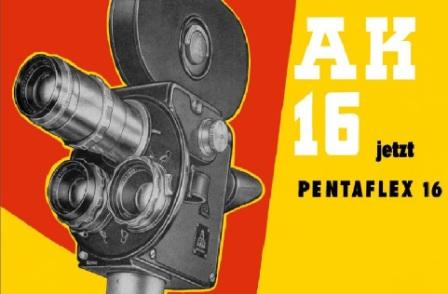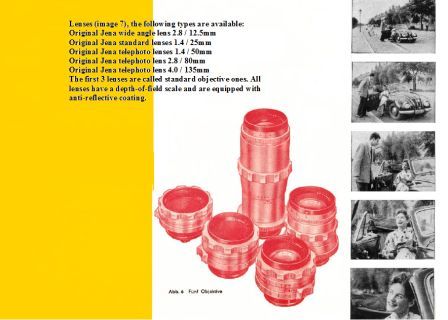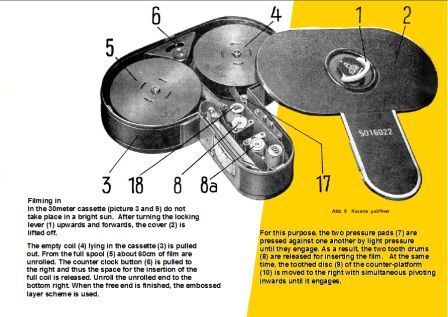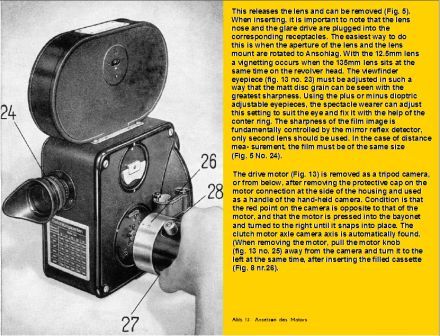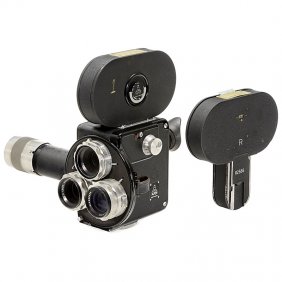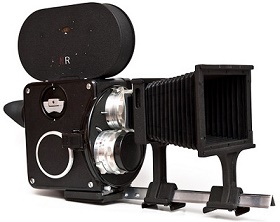Pentacon Pentaflex 16
Pentacon Pentaflex 16
Year: approx. 1950-1970
Lens: triple lens mount, Pentaflex mount
- often sold with the following Zeiss lenses: 2.8/12.5mm, 1.4/25mm and 1.4/50mm
- Sometimes also sold with a Pentovar 16 1:2.8 15-60mm - 1:5.6 30-120mm. (These optics have a variable focal length due to a removable lens.)
Reflex view finder with an unusual optical path that runs under the camera instead of above the film chamber.
Manual zoom (when equipped with zoom lenses).
Manual exposure only (no integrated exposure meter).
Camera was sold with several motors:
- A spring wound motor with various speeds
- An electrical mains powered motor for 25fps constant speed
- A 12v battery powered motor that runs between 12 to 36fps.
- The fastest electrical motor runs at a maximum of 96fps.
The motor can be mounted in two positions on the camera, side and bottom (for hand held operation). The motor is interchangeable in most models.
Single frame exposure is also possible via an attached intermediate gear.
Variable shutter (0 - 180°)
No sound recording - a non-quite camera made for B roll or post sound recording
Made in GDR
Contents
Additional information[edit]
Magazines/Film[edit]
Camera takes single and double-perf 16mm-film. There are three different film magazines or cassettes: 30m/100ft, 60m/200ft and 120m/400ft. The 30m/100ft and 60m/200ft magazines can take daylight spools, while the 120m/400ft has to be loaded in complete darkness. As the film is threaded entirely within the magazine, several magazines can be inserted into the camera body during filming, with minimal interruption. The most common magazines currently available are 30m/100ft. Cassettes that are suitable for reverse function are labelled "R". and may come with an electrical attachment on the cassette. Cassettes for use with the 96Fps motor are labelled "96" and contain the instruction "use coated film" (presumably meaning a film stock with a smooth coating) For all 24Fps filming purposes, any cassette can be used.
Accessories[edit]
A lot of accessories have been developed for the popular camera (Text courtesy of: http://www.vesab.de/wpvesab/fotografie/pentacon-filmkamera-ak16-2877/):
- Synchronous motor for TV pictures (25 B / s)
- Centrifugal motor with various speeds of 12 to 36 B / s (12 V DC)
- Clockwork motor
- Frame transmission
- Normal cassette (N) and cassette for reverse (R)
- Hand crank can be attached to the motor flange
- Extractable two-part compendium with filter holder and front insert
- Chest support for motor
- Hand crank can be attached to the motor flange
- M42 lens adapter
Quotes[edit]
"The Pentacon AK16 is a 16 mm film camera with exchangeable cassettes and various drives. As a special feature, it has an adjustable shutter. The nosepiece picks up three lenses and has a synchro-aperture adjustment, meaning all the lenses mounted retain the same setting so the user does not have to re-set for each lens choice. For the time, this camera was extremely advanced. It was developed in the 1950s by the VEB Pentacon Camera and Cinema Works (VEB Zeiss-Ikon) (sold in 1953) and was used extensively by many studios in the East until the late 1980s. ... What is the difference between a Pentacon AK16 and a Pentaflex 16? The AK16 was first and is black. At the end of production time, savings had to be made due to the socialist planned economy, which affected some of the features of the camera. They were called Pentaflex 16 and gave it a new look. But it was not changed that much. Obviously, the silver leather and the cheap gray hammered finish - the good black Kräusellack was more expensive then." (Text translated from: https://www.vesab.de/wpvesab/fotografie/pentacon-filmkamera-ak16-2-2877/ )
Comments[edit]
There are several versions of this camera: some with plastic parts for the body, some with fully metallic bodies. And "of course" the body's colour can be anything from silver metallic, to green, grey, brown or black.
- An English Pentaflex 16 advertisement from 1965
- An English translated user manual can be downloaded here.
- There are English translation operating manuals on this site. Also many links to helpful pages.
- Link to a page detailing a quick "service" and lube of a Pentaflex AK16 camera.
- Link to a page detailing a Pentaflex motor refurbish
- Link to a page detailing a Pentaflex magazine disassemble
Commercial usage (after 2000)[edit]
Director JEFF L’HEUREUX completed in 2012 a feature film called "Shadow of the Lotus" that was shot using two Pentaflex 16mm cameras. FujiFilm was used as the director desired a recreate a "gritty, grainy look of older 35mm film stock is faithfully recreated on 16mm film, complete with the signature scratches and natural imperfections of film stocks at the time".
Reviews[edit]
eBay Auctions[edit]
